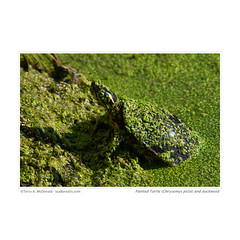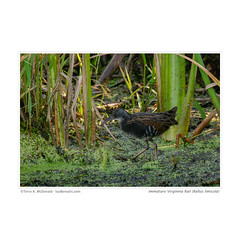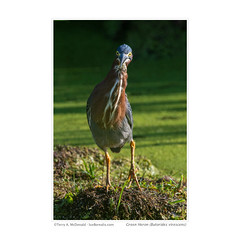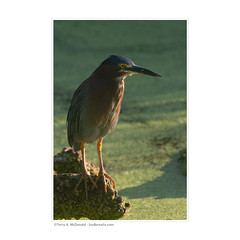OM-1 Field Testing

What can I say, other than, “Wow!”
A camera is a tool, allowing me to capture and communicate the world as I see it. I’ve always leaned towards simplicity in my tools, working at the pace of landscapes with tripods. The OM-1 allows this. While there is the pull of exercising all the bells and whistles, I can still dial everything back to a simple viewfinder with simple controls to point, focus, adjust and shoot. That’s my C1 setting with highlight and shadow warnings on. Base ISO of 200. Aperture priority ƒ5.6 to start. AF-S. Single frame silent shutter. But, at the push of a button, I can switch to High Res mode or Focus Stacking, or HDR or Keystone control. At this stage, I just need to remember which mode is mapped to which button. 😊

OM-1 w/ M. Zuiko Digital 100-400mm ƒ5.0-6.3 at 123mm; ƒ8 @ 1/250; ISO 200; EV–⅔; Handheld High Res. At shutter speeds like this, HHHR is completely usable – a great tool to add to the box!

OM-1 w/ 100/400 ƒ5.0-6.3 at 100mm; ƒ11 @ 1/160; ISO 200; EV-1⅓
This image confirmed two things for me: (1) ƒ11 is completely usable with no sign of diffraction;
(2) I can pull detail out of deep shadows with no loss of quality. Of course, there is always HDR, which I should have tried here. Duh!

Left: No Keystone Control, but the framing I wanted.
Centre: The resulting full-res JPEG with Keystone Control applied.
Right: The full-res RAW file from which the JPEG was created in-camera, so I have the original if I need to change anything. This will be very helpful when travelling and shooting architecture. Having both the JPEG and the RAW is a bonus.
I’ve always considered myself to be “in the know” about photography. During high school, I cut my teeth working in an independent photography store (Connaught Camera in Hamilton, Ontario). My boss, the owner, Jim Prestige, was clear about learning every camera and system inside, outside, upside, downside. He wouldn’t even let me on the selling floor until I could calculate sales tax in my head. “I don’t want you to lose a sale because you’re fumbling over numbers,” he would say.
Nikon, Minolta, Pentax, Ricoh, Konica, Olympus, Contax. But not Leica. Leica was for our ‘Leica Man’ who could sweet talk people out of thousands when the other gear was going for hundreds. And not Canon. “Eddie Blacks carries Canon and I can’t touch their margins,” Jim would say. In the few years I was there, working only weekends and Christmas holidays, I was top in sales twice. The first time was when I sold about a dozen Minoltas in a month. At the time I was using a Minolta XD-11 with some beautiful Minolta lenses. Their 100mm MD macro was top-notch.
The second time was when I sold about a dozen Nikons over Christmas. FMs, FEs, EMs and even an F3. Whoa! Now that was a camera!
But enough history . . .
Those are old systems, long gone, and in retrospect, very simple: Point, focus, adjust, shoot. Photography has come a long way!
I am blown away by the options provided by the OM-1. It’s taking me some time to wrap my head around AF Target, AF Area, and AF Tracking; the advantages of S-AF over C-AF and vice versa; SH1 and SH2; ProCapture; plus all the computational photography options. As I said, “Wow!” For an hour at a time, I immerse myself in learning the ins and outs of one group of settings and options and emerge with a new way of tackling the world of photography.
Right now, it seems overwhelming, but I know this system is cutting edge and it is the future of photography. The beauty of it is that I can still point, focus, adjust and shoot.
Yes, I’m impressed
The engineers behind this camera have built into it a myriad of settings that have become fundamental to landscape, nature and travel photography. And more! And that’s where the real learning begins.
The stabilisation built into the camera and lenses is phenomenal. I’m not yet ready to put away my tripod (I’m looking forward to capturing 80mp landscapes!), but for walkabouts, the stabilisation really is surprising.

OM-1 w/ 100-400 ƒ5.0-6.3 at 400mm; ƒ11 @ 1/800; ISO1600; EV-1
Amazing! An 800mm field of view hand held shot. A small aperture to increase depth-of-field. No visible noise at ISO 1600. Below: A crop of the same image at 100%.No noise, sharp as a tack, and only 1.3 metres (4 feet) away..


This photo combines a number of attributes of the OM-1 system.
Having tried the shot handheld at 1.3 seconds at ISO 200 and failing, I upped the ISO to 1600. The next shot was at ⅛ sec, handheld at 100mm (200mm in FF terms), and is perfectly sharp. Moreover there is no discernible noise at ISO1600 despite the poor lighting. In fact, that brings up the third bonus – the white balance and exposure are bang on. This was made under a dim sulphur-yellow bulb in the maintenance yard in Guelph at 6am!
The thing about noise . . .
Have I said how impressed I am with the noise levels? Even better is the fact that all of these photos were processed through Lightroom Classic. It handles OM-1 noise well, but not perfectly. It seems lighting conditions have an effect on noise, beyond what you would expect from simple ISO and exposure. I made a few shots at ISO 1600 where I found the noise at 100% a bit on the salt-and-pepper side. Let me say, though, that In a print, the noise would not at all be noticeable. I’m just pixel-peeping.
However, I knew I should have a look into this noise “issue”. Having heard about the wonders of OM Workspace, I processed the same image through it, only applying the AI Noise Reduction before exporting the image back to LR as a 16-bit TIFF. Thes is the only way I can maintain original quality out of OM Workspace, as it does not produce DNGs.
Guess what? No noise. I mean zero. Yet all the same fine detail is there. Wow!

Now for the leap . . .
The area of photography I am now gunning towards is capturing birds. An 800mm fov lens, really opens up the potential for birds in flight and birds in general. I’ve been pleased with the responsiveness of the system. The camera goes from sleep to active in the time it takes me to raise it to eye level. And, its ability to acquire focus (once I’ve set it up properly) is brilliantly fast. The photo below is an example of just this. I heard the geese, raised the camera and fired, taking only a split second to frame the pair. I was in single-shot mode, not prepared for this kind of shot, but still came away with 3 photos. The sun had just risen providing some beautiful lighting.

OM-1 w/ 100-400 ƒ5.0-6.3 at 100mm; ƒ8 @ 1/400; ISO 200
However, it is the potential offered by Pro Capture that is next on my list. But first, I just need to re-map my brain into a new way of approaching photography using this unique technology. What Pro Capture does is, after half-pressing the shutter release, it begins saving frames. So, when the shutter release is fully pressed, it takes the photo AND it keeps previous frames it had been saving. Not minutes of photos (thank goodness), but rather whatever limit you choose as the photographer; e.g. 50 frames. Tom Stirr has a good article about it as does Espen Helland (who also produces very helpful videos over on YouTube).
Think of a bird on a branch. You half-press the shutter, waiting for it to take off. Once it takes off, you fully depress the shutter and voilà, you have the moment before it took off, the moment it took off and the moment after it took off. Henri Cartier-Bresson would call it cheating, I’m sure, as you no longer need to anticipate the exact decisive moment – Pro Capture does it for you. At least that’s how it works in theory. I’m having trouble wrapping my brain around shooting a millisecond after the decisive moment, when I’m so used to anticipating it. But, as I said in my last post, this old dog can learn new tricks. I can’t say I’ve had great success, the few times I’ve tried it, but my technique is progressing.
Stay tuned!

OM-1 w/ Zuiko 100-400 ƒ5.0-6.3 at 400mm; ƒ6.3 @ 1/1600; ISO 1600
Thanks for reading! If you have a question, just pop it into the comments below. If you’re enjoying these blogs, I invite you to Subscribe!
To see more of my work, head over to luxBorealis.com





Thanks for the inspiration, Terry. I have been field testing my new M.Zuiko ED 100-400mm lens over the past week or so, after its very timely arrival (ordered on a Friday evening, at my door the next Wednesday). After several outings to the Huron, Dickson, Sudden Tract and the banks of the Grand River, I have concluded that it is high time to reacquaint myself with the power of my OM-D. I have been treating the beast as a point and shoot device over the last couple of years, too lazy to brush up on many of the powerful features that the camera offers.a I started yesterday by upgrading the software, something I hadn’t done in a long while. I am taking your suggestion of spending an hour just getting to know one grouping of controls. Although I managed to get a number of impressive shots this week, there were many more that were not properly focussed (especially on or near water) or with faster moving birds, so I am starting with the S-AF vs C-AF distinction and checking out the Hellend video on Pro Capture. Hope to have better luck once I re-internalize more of the inner workings of this wonderful tool.
Hi Dan
Glad to hear you’re “getting back into it”. The 100-400 is wonderful to handhold.
Here is a link I found helpful for AF: https://mirrorlesscomparison.com/about-us/
As well, OM System folks spoke in an interview about the importance of separating C-AF and Tracking AF: “If you try to shoot the subject, for example a cat or a bird, we recommend Target AF and CAF — not tracking AF — with AI subject detection.” (from: https://www.imaging-resource.com/news/2022/10/07/OMDS-2022-interview-great-outlook-aiaf-vs-tracking-af-150-400-eye-candy).
Once the teaching year is finished, we’ll get together for some local shooting (or maybe a canoe trip again!)
BTW, the files at ISO 1600 and 3200 are cleaning up well. At least that’s what I thought using OM Workspace. Then ran the same files through Lightroom Classic 12.3 “Denoise” (update just released) and I’m blown away by the improvement.
Stay well and keep shooting!
Terry